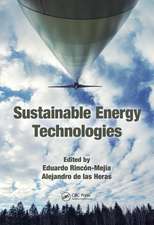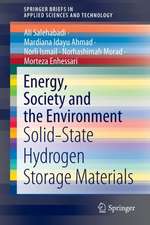Energy Recovery Technology for Building Applications: Green Innovation towards a Sustainable Future
Autor Mardiana Idayu Ahmad, Saffa Riffaten Limba Engleză Paperback – 14 iul 2021
This book will be used as a general and technical reference book for students, engineers, professionals, practitioners, scientists, and researchers seeking to reduce energy consumption of buildings in various climatic conditions.
- Presents an overview of energy consumption scenarios in buildings and the needs for energy-efficient technologies at regional and global levels;
- Explains models and methods of energyrecovery technology performance evaluation;
- Inspires further research into energy recovery technology for building applications.
| Toate formatele și edițiile | Preț | Express |
|---|---|---|
| Paperback (1) | 620.21 lei 43-57 zile | |
| Springer International Publishing – 14 iul 2021 | 620.21 lei 43-57 zile | |
| Hardback (1) | 626.15 lei 43-57 zile | |
| Springer International Publishing – 14 iul 2020 | 626.15 lei 43-57 zile |
Preț: 620.21 lei
Preț vechi: 729.67 lei
-15% Nou
Puncte Express: 930
Preț estimativ în valută:
118.70€ • 123.29$ • 98.59£
118.70€ • 123.29$ • 98.59£
Carte tipărită la comandă
Livrare economică 03-17 februarie 25
Preluare comenzi: 021 569.72.76
Specificații
ISBN-13: 9783030500085
ISBN-10: 303050008X
Ilustrații: XV, 126 p. 26 illus., 18 illus. in color.
Dimensiuni: 155 x 235 mm
Greutate: 0.21 kg
Ediția:1st ed. 2020
Editura: Springer International Publishing
Colecția Springer
Locul publicării:Cham, Switzerland
ISBN-10: 303050008X
Ilustrații: XV, 126 p. 26 illus., 18 illus. in color.
Dimensiuni: 155 x 235 mm
Greutate: 0.21 kg
Ediția:1st ed. 2020
Editura: Springer International Publishing
Colecția Springer
Locul publicării:Cham, Switzerland
Cuprins
Chapter 1. Introduction: Energy, Green Innovation and Sustainable Future.- Chapter 2. Building Energy Consumption and Energy Efficiency Strategies.- Chapter 3. Definition and Working Principle of Energy Recovery Technology.- Chapter 4. Heat Exchanger: The Heart of Energy Recovery System.- Chapter 5. Classification and Types of Energy Recovery Systems.- Chapter 6. Evaluating the Performance of Energy Recovery Systems.- Chapter 7. Energy Recovery in Integrated or Hybrid Systems towards Energy-Efficient Technologies.- Chapter 8. Application of Energy Recovery Systems in Various Climatic Conditions.
Notă biografică
Dr. Mardiana Idayu Ahmad is Associate Professor in Energy and Environmental Technology within the School of Industrial Technology at the Universiti Sains Malaysia (USM) Penang, Malaysia. Dr. Ahmad earned her Ph.D in Sustainable Energy Technologies from the University of Nottingham in the United Kingdom. She is a member of Institution of Engineering & Technology (IET) UK and a member of World Society of Sustainable Energy Technologies (WSSET). She has significant experience in the field of environmental management, risk assessment as well as renewable and sustainable energy technologies, particularly in energy recovery technology, solar photovoltaic, desiccant dehumidification and integrated building design/system. She has published over 100 articles in internationally respected resources, including research and popular books, conference proceedings and scientific journals. Her primary research interests include: renewable & sustainable energy technologies, integrated building technologies, HVAC & desiccant dehumidification, IAQ and building ventilation, environmental management, and hazardous chemicals & risk assessment.
Dr. Saffa Riffat, BSc DSc MSc DPhil CEng FIMechE FCIBSE FInstE, holds the post of Chair in Sustainable Energy Technology; Head of the Institute of Sustainable Energy Technology and Head of the Institute of Building Technology at the University of Nottingham. He has a wide range of experience of renewable energy, sustainable buildings, refrigeration, heat transfer, heat pumps, ventilation and air quality. He has obtained grants in excess of £17 million from the EPSRC, EU and industry and published over 350 refereed papers on HVAC systems. Professor Riffat has been awarded the degree of Doctor of Science (DSc) from the University of Oxford for his research contribution in the field of heat pumps and ventilation technology. He is named as the inventor on 20 International Patents. Professor Riffat is a member of the EPSRC College of Peers as well as the Editorial Board of the Journal of Applied Thermal Engineering, the Journal of Green Energy, Renewable Energy and Ambient Energy and the International Journal in Architectural Engineering and Design Management.Professor Riffat has been awarded honorary Professorships by Chongqing University and Dalian University, China for his research achievements. He is a Chartered Mechanical Engineer, Fellow of the Institute of Mechanical Engineers, Fellow of the Chartered Institute of Building Services Engineers, Fellow of the Energy Institute and Fellow of World Innovation Foundation. He has also been awarded the Community Award for Exceptional Individual, the Euro Solar Award and the CIBSE Baker Silver Medal. Professor Riffat is also a member of the Advisory Boards of several companies including Baxi Group Limited, David Wilson Homes Limited and Premas International Limited. Professor Riffat has acted as the chairman of several conferences including the Sustainable Energy Technologies 1&2 and the Energy Conversion & Application Conference 2000. He has given numerous keynote papers and chaired sessions at International Conferences including Heat Powered Cycles Conference, CIBSE Conferences, Sustainable Construction Forums, COGEN Conference and World Renewable Energy Congresses.
Dr. Saffa Riffat, BSc DSc MSc DPhil CEng FIMechE FCIBSE FInstE, holds the post of Chair in Sustainable Energy Technology; Head of the Institute of Sustainable Energy Technology and Head of the Institute of Building Technology at the University of Nottingham. He has a wide range of experience of renewable energy, sustainable buildings, refrigeration, heat transfer, heat pumps, ventilation and air quality. He has obtained grants in excess of £17 million from the EPSRC, EU and industry and published over 350 refereed papers on HVAC systems. Professor Riffat has been awarded the degree of Doctor of Science (DSc) from the University of Oxford for his research contribution in the field of heat pumps and ventilation technology. He is named as the inventor on 20 International Patents. Professor Riffat is a member of the EPSRC College of Peers as well as the Editorial Board of the Journal of Applied Thermal Engineering, the Journal of Green Energy, Renewable Energy and Ambient Energy and the International Journal in Architectural Engineering and Design Management.Professor Riffat has been awarded honorary Professorships by Chongqing University and Dalian University, China for his research achievements. He is a Chartered Mechanical Engineer, Fellow of the Institute of Mechanical Engineers, Fellow of the Chartered Institute of Building Services Engineers, Fellow of the Energy Institute and Fellow of World Innovation Foundation. He has also been awarded the Community Award for Exceptional Individual, the Euro Solar Award and the CIBSE Baker Silver Medal. Professor Riffat is also a member of the Advisory Boards of several companies including Baxi Group Limited, David Wilson Homes Limited and Premas International Limited. Professor Riffat has acted as the chairman of several conferences including the Sustainable Energy Technologies 1&2 and the Energy Conversion & Application Conference 2000. He has given numerous keynote papers and chaired sessions at International Conferences including Heat Powered Cycles Conference, CIBSE Conferences, Sustainable Construction Forums, COGEN Conference and World Renewable Energy Congresses.
Textul de pe ultima copertă
This book discusses energy recovery technology, a green innovation that can be used in buildings. This technology reduces energy consumption in buildings and provides energy savings to conventional mechanical ventilation systems. Divided into eight chapters, the book provides in-depth technical information, state-of-the-art research, and latest developments in the energy recovery technology field. Case-studies describe worldwide applications of energy recovery technology and its integrated system for building services.
This book will be used as a general and technical reference book for students, engineers, professionals, practitioners, scientists, and researchers seeking to reduce energy consumption of buildings in various climatic conditions.
This book will be used as a general and technical reference book for students, engineers, professionals, practitioners, scientists, and researchers seeking to reduce energy consumption of buildings in various climatic conditions.
- Presents an overview of energy consumption scenarios in buildings and the needs for energy-efficient technologies at regional and global levels;
- Explains models and methods of energy recovery technology performance evaluation;
- Inspires further research into energy recovery technology for building applications.
Caracteristici
Presents an overview of energy consumption scenarios in buildings and the needs for energy-efficient technologies at regional and global levels Explains models and methods of energy recovery technology performance evaluation Inspires further research into energy recovery technology for building applications
























